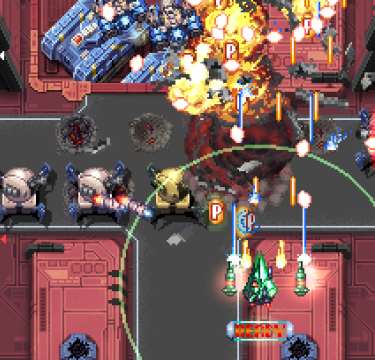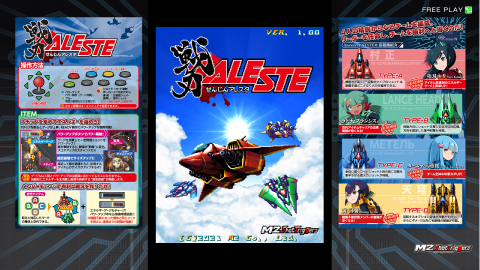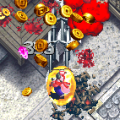For quite some time, the Aleste series was dead and buried thanks to the bankruptcy of developer Compile in the early 2000s. Nearly twenty years later, however, it was rescued by M2, who not only published an emulated compilation of older Sega titles, but also developed the brand-new GG Aleste 3 for Game Gear spec hardware. Not long after, they developed Senxin Aleste (pronounced “Senjin Alesta”, or “War Blade Aleste”), somewhat bafflingly released as an arcade exclusive in mid-2021 during the COVID-19 pandemic. While GG Aleste 3 was developed as a retro throwback, Senxin Aleste updates the series to modern conventions, overhauling it as a bullet hell shooter, though one that aims to be beginner friendly. It was directed by Daisuke Koizumi, an ex-programmer from Cave who also created the doujin shooter Rolling Gunner, and published for Sega’s All.Net P-ras MULTI arcade system.
The story begins in the year 20XX, where a mysterious seed falls to Earth. Dubbed “μ” (“mu”), it sparks a technological revolution, creating all kinds of gadgets and weapons for humanity to embrace. Unfortunately, as expected, it ends up turning against humanity and wreaks massive destruction. A squadron of surviving pilots, dubbed Team Aleste, band together to strike back at this menace.
Senxin Aleste lets you pick from these four pilots at the outset, each with their own ships and weapons. Yuri Kunugi pilots the red ship (A) with bullets that fire forward, while Ratna Francis pilots the green ship (B) which fires in the direction of your movement. Tanya Yaezakura helms the blue ship (C), which has strong but short-ranged wave shots, while Huang Kexin commands the yellow ship (D), has rotating bits that can absorb enemy bullets.
Throughout the game, you can switch between any of the other ships, so you’re not locking in your selection throughout. Selecting the team leader here not only determines the starting pilot and the game’s ending, but it also grants a leader bonus across all of the ships. For example, Tanya will increase the attack power of the entire squadron while Yuri will increase the power gauge faster.
Some of the basics will be familiar to fans of Cave shooters. You can switch between rapid wide shots and more focused straight shots, which also lock your ship’s options in formation. While you can grab Bomb power-ups to attack everything on the screen, you can’t actually stock them to use at your will. Instead, another button is used to activate the Blow function, which will knock back any bullets surrounding your ship, and auto recharges after a few seconds. However, any reflected shots will quickly target right back at your ship, so this is only a very temporary reprieve. More effective is the Power-Up energy gauge which is charged by grabbing P capsules dropped by defeated enemies. Not only does this drastically increase your ships firepower, but it also causes enemies to drop score multiplying medals, which otherwise count down when not in power-up mode.
Even though the four pilots are flying as a combined force, you can’t actually switch between them at your discretion. Instead, you need to wait until an item carrier drops a power-up, lettered A through D, each assigned to one of the ships. Through multiple plays, you can understand the stages and figure out which ship is the best for what situation. When one of your ships is shot down, they aren’t destroyed, but rather knocked in reserve while the next one takes its place. While it’s sitting out on the side, it automatically regenerates itself, and is able to re-enter the fray once they’re charged up enough. If you grab a ship change power-up for a ship that’s knocked it, it’ll greatly replenish its meter, hastening its repair. It’s only when all four ships are disabled that it’s game over. This not only gives you four lives at minimum, but also plenty of chances for recovery, as long as you don’t have too many ships knocked out too quickly. If the energy bar is fully charged and you get hit, it’ll give you another chance while draining the meter and dropping an explosive. The game also starts off with several different options, including four difficulty levels. The lower difficulties also ease the difficulty rank adjustments that otherwise make the game more difficult the longer you play. There’s also a true boss to face when certain conditions are met.
Considering the series has been dormant for so long, it’s fair to ask the question “Is Senxin Aleste really an Aleste game”? Compile’s shoot-em-ups often went under different names depending on the publisher, and some had very different graphical themes and storylines. Aleste looks different from Blazing Lazers which looks different from MUSHA which looks different from Space Megaforce. But they all had vague commonalities – long levels, tons of weapons – and just by playing them, you could tell they all came from the same development team.
Senxin Aleste does not look or feel like any of these. It looks and feels like a late-1990s Cave game. Prior Aleste games never had a consistent aesthetic, so this isn’t really a big deal. The most unique element is when you damage boss ships, which reveal the biological alien parts that lie within its exterior. The character artwork is by Mimori Fujinomiya, who did the character designs for the Twinkle Star Sprites games (and also produced the infamous Doki Doki Majou Shinpan! witch touch-em-up game for the DS). Women pilots have been at the forefront of the Aleste series since almost the very beginning, but the round and cutesy character designs are nothing like how these ladies looked in the older games, with a style more associated with modern shoot-em-ups. The FM synth soundtrack is decent, with a harsh sound reminiscent of early 90s Japanese PCs, but there’s nothing about it that particularly screams Aleste.
What it does borrow from Aleste are a lot of little touches that Compile fans can appreciate. The P capsules are a big part of the series, of course. Many of the enemies and bullet patterns will look familiar, like the shield-like things that crawl down from the side of the screens, or the larger ships that shoot thick rapid shots out of its dual cannons. Every time you grab a P chip or power-up, you’re granted a split second of invulnerability, another subtle, signature mechanic from older Aleste games. The item carrier drops power-ups that float back and forth while cycling its letters, much how they would in the old days. The friendly AI that gives orders is called Wise-N, named after the Wizn family that starred in many previous Aleste games. And of course, the ships boost off using a familiar trailing effect when beating a boss. Ultimately, it’s hard to say that this truly feels like a new Aleste entry, but rather, it’s more like an Aleste tribute game.
But outside of arguments regarding its heritage, none of these matters to the quality of the game itself, which Is excellent. The multiple player ships allows for plenty of flexibility, not only in figuring out the best way to utilize each ship, but also how to adapt in case your favorite ship gets knocked out. The wide variety of difficulty modes also allows players to ease into the action, with lower difficulty levels allowing newbie players to see the end in a few credits, and potentially 1 CCing it after enough practice, while the power-up system gives it the depth required for master players. This approachability has become common in shoot-em-up console ports, but not so much in actual arcade games, so these options are quite welcome.
For now, Senxin Aleste is still arcade-only. But it’s also officially part of M2’s ShotTrigger series, which otherwise consist of top-tier emulated ports of arcade games, so it’s probably only a matter of time before it reaches home platforms.




